
Charles De Wailly
Encyclopedia
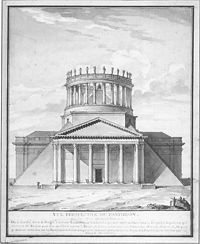
Architect
An architect is a person trained in the planning, design and oversight of the construction of buildings. To practice architecture means to offer or render services in connection with the design and construction of a building, or group of buildings and the space within the site surrounding the...
and urbanist, and furniture designer, one of the principals in the Neoclassical revival
Neoclassicism
Neoclassicism is the name given to Western movements in the decorative and visual arts, literature, theatre, music, and architecture that draw inspiration from the "classical" art and culture of Ancient Greece or Ancient Rome...
of the Antique. His major work was the Théâtre de l'Odéon
Odéon
The Odéon-Théâtre de l'Europe is one of France's six national theatres.It is located at 2 rue Corneille in the 6th arrondissement of Paris on the left bank of the Seine, next to the Luxembourg Garden...
for the Comédie-Française
Comédie-Française
The Comédie-Française or Théâtre-Français is one of the few state theaters in France. It is the only state theater to have its own troupe of actors. It is located in the 1st arrondissement of Paris....
(1779–82). In his designs, De Wailly showed a predilection for the perfect figure, the circle.
Biography
De Wailly was born in ParisParis
Paris is the capital and largest city in France, situated on the river Seine, in northern France, at the heart of the Île-de-France region...
.
Starting in 1749, he was the pupil of Jacques-François Blondel
Jacques-François Blondel
Jacques-François Blondel was a French architect. He was the grandson of François Blondel , whose course of architecture had appeared in four volumes in 1683 -Biography:...
at l'École des Arts, where he met William Chambers
William Chambers (architect)
Sir William Chambers was a Scottish architect, born in Gothenburg, Sweden, where his father was a merchant. Between 1740 and 1749 he was employed by the Swedish East India Company making several voyages to China where he studied Chinese architecture and decoration.Returning to Europe, he studied...
and had as a schoolmate Marie-Joseph Peyre
Marie-Joseph Peyre
Marie-Joseph Peyre was a French architect who designed in the neoclassical style.- Biography :He began his training in Paris with Jacques-François Blondel at l'École des Arts, where he met Giovanni Niccolo Servandoni and formed a life-long friendship with Charles De Wailly...
; later he studied with Giovanni Niccolò Servandoni
Giovanni Niccolo Servandoni
Jean-Nicolas Servan, also known as Giovanni Niccolò Servando or Servandoni was a French decorator, architect, scene-painter and trompe-l'œil specialist.He was the son of a carriage-builder at Lyon....
and with Jean-Laurent Le Geay
Jean-Laurent Le Geay
Jean-Laurent Le Geay was a French neoclassical architect with an unsatisfactory career largely spent in Germany. His artistic personality remained shadowy until recently, though he was allowed to have had numerous pupils among the avant-garde of neoclassicism...
. After having obtained the Prix de Rome
Prix de Rome
The Prix de Rome was a scholarship for arts students, principally of painting, sculpture, and architecture. It was created, initially for painters and sculptors, in 1663 in France during the reign of Louis XIV. It was an annual bursary for promising artists having proved their talents by...
for architecture in 1752 he went to the French Academy in Rome
French Academy in Rome
The French Academy in Rome is an Academy located in the Villa Medici, within the Villa Borghese, on the Pincio in Rome, Italy.-History:...
for three years until 1755, sharing his prize with his friend Pierre-Louis Moreau-Desproux
Pierre-Louis Moreau-Desproux
Pierre-Louis Moreau-Desproux was a pioneering French neoclassical architect.Though he did not gain the Prix de Rome that was the dependable gateway to a prominent French career in architecture, his fellow-student Charles de Wailly invited him to share his prize...
. Both participated in the excavations at the Baths of Diocletian
Baths of Diocletian
The Baths of Diocletian in Rome were the grandest of the public baths, or thermae built by successive emperors. Diocletian's Baths, dedicated in 306, were the largest and most sumptuous of the imperial baths. The baths were built between the years 298 AD and 306 AD...
. In Rome, De Wailly founded a friendship with the sculptor Augustin Pajou
Augustin Pajou
Augustin Pajou was a French sculptor, born in Paris. At eighteen he won the Prix de Rome, and at thirty exhibited his Pluton tenant Cerbère enchaîné .-Selected works:...
, who was to carve his bust and that of his wife and for whom, in 1776, he would build a house adjoining his own, in Paris.
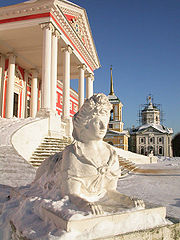
Goût grec
Goût grec is the term applied to the earliest expression of the neoclassical style in France, it refers specifically to the decorative arts and architecture of the mid-1750s to the late 1760s. The style was more fanciful than historically accurate though the first archaeological surveys of Greece...
", by exhibiting a table with a lapis lazuli top and gilt-bronze mounts and a granite vase in the "goût antique" at the Salon of 1761
Paris Salon
The Salon , or rarely Paris Salon , beginning in 1725 was the official art exhibition of the Académie des Beaux-Arts in Paris, France. Between 1748–1890 it was the greatest annual or biannual art event in the Western world...
; they were designed to be manifestos of a new taste, as the squib inserted in the Mercure de France
Mercure de France
The Mercure de France was originally a French gazette and literary magazine first published in the 17th century, but after several incarnations has evolved as a publisher, and is now part of the Éditions Gallimard publishing group....
states, in a "very noble style, far removed from the frippery manner ("air de colifichet") which has reigned so long in our furnishings" (Eriksen 1974:274) About 1764, for the sumptuous Hôtel d'Argenson de Voyer, whicht he remodelled for Marc-René d'Argenson, marquis de Voyez in an advanced neoclassical style, he designed the gilt-bronze mounted marble and porphyry vase on pedestal that is now in the Wallace Collection
Wallace Collection
The Wallace Collection is a museum in London, with a world-famous range of fine and decorative arts from the 15th to the 19th centuries with large holdings of French 18th-century paintings, furniture, arms & armour, porcelain and Old Master paintings arranged into 25 galleries.It was established in...
, London; from De Wailly's drawings the sculptor Augustin Pajou
Augustin Pajou
Augustin Pajou was a French sculptor, born in Paris. At eighteen he won the Prix de Rome, and at thirty exhibited his Pluton tenant Cerbère enchaîné .-Selected works:...
made the wax models for the mounts.
In 1767, De Wailly was accepted as a member of the first class of the Royal Académie d'architecture
Académie d'architecture
The Académie royale d'architecture was a French learned society founded on December 30, 1671 by Louis XIV, king of France under the impulsion of Jean-Baptiste Colbert...
and, in 1771, was accepted in the Académie royale de Peinture et de Sculpture, the only professional architect of the time to win admission, a mark of his great facility as a draughtsman. Henceforth De Wailly regularly exhibited at the Paris Salon
Paris Salon
The Salon , or rarely Paris Salon , beginning in 1725 was the official art exhibition of the Académie des Beaux-Arts in Paris, France. Between 1748–1890 it was the greatest annual or biannual art event in the Western world...
s his renderings, designs and models. He gained wider publicity when two of his designs were engraved for the Encyclopédie
Encyclopédie
Encyclopédie, ou dictionnaire raisonné des sciences, des arts et des métiers was a general encyclopedia published in France between 1751 and 1772, with later supplements, revised editions, and translations. It was edited by Denis Diderot and Jean le Rond d'Alembert...
and two more for the monumental Description de la france of the 1780s.
His reputation abroad grew through engravings of his works; he became particularly popular in Russia
Russia
Russia or , officially known as both Russia and the Russian Federation , is a country in northern Eurasia. It is a federal semi-presidential republic, comprising 83 federal subjects...
, where his disciples, some of whom went to Paris to study with him directly, included Vasily Bazhenov, Ivan Starov
Ivan Starov
Ivan Yegorovich Starov was a Russian architect from St. Petersburg who devised the master plans for Yaroslavl, Voronezh, Pskov, Dnipropetrovsk, Mykolaiv, and many other towns in Russia and Ukraine...
, and Andrey Voronikhin
Andrey Voronikhin
Andrey Nikiforovich Voronikhin was a Russian architect and painter. As a representative of classicism he was also one of the founders of the monumental Russian Empire style...
. Catherine the Great offered him a high post in the Imperial Academy of Arts
Imperial Academy of Arts
The Russian Academy of Arts, informally known as the St. Petersburg Academy of Arts, was founded in 1757 by Ivan Shuvalov under the name Academy of the Three Noblest Arts. Catherine the Great renamed it the Imperial Academy of Arts and commissioned a new building, completed 25 years later in 1789...
, St Petersburg, which he refused.
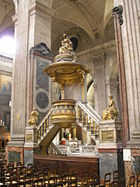
Château de Fontainebleau
The Palace of Fontainebleau, located 55 kilometres from the centre of Paris, is one of the largest French royal châteaux. The palace as it is today is the work of many French monarchs, building on an early 16th century structure of Francis I. The building is arranged around a series of courtyards...
, jointly with Marie-Joseph Peyre
Marie-Joseph Peyre
Marie-Joseph Peyre was a French architect who designed in the neoclassical style.- Biography :He began his training in Paris with Jacques-François Blondel at l'École des Arts, where he met Giovanni Niccolo Servandoni and formed a life-long friendship with Charles De Wailly...
. The following year, he was authorized to leave for a long stay in Genoa
Genoa
Genoa |Ligurian]] Zena ; Latin and, archaically, English Genua) is a city and an important seaport in northern Italy, the capital of the Province of Genoa and of the region of Liguria....
, to redecorate the seventeenth-century palace of Cristoforo Spinola in the Strada Nuova, working in tandem with Andrea Tagliafichi: the building was badly damaged in 1942. He was to return on several occasions to work in Italy.
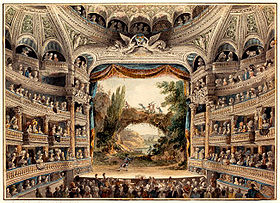
Abel-François Poisson, marquis de Marigny
Abel-François Poisson de Vandières, marquis de Marigny and marquis de Menars , often referred to simply as marquis de Marigny, was a French nobleman who served as the director general of the King's Buildings...
, brother of Mme de Pompadour
Madame de Pompadour
Jeanne Antoinette Poisson, Marquise de Pompadour, also known as Madame de Pompadour was a member of the French court, and was the official chief mistress of Louis XV from 1745 to her death.-Biography:...
and general director of the Bâtiments du Roi
Bâtiments du Roi
The Bâtiments du Roi was a division of Department of the household of the Kings of France in France under the Ancien Régime. It was responsible for building works at the King's residences in and around Paris.-History:...
, De Wailly worked in the park of Marigny's Château de Menars
Château de Menars
The Château de Menars is a château associated with Madame de Pompadour situated on the bank of the Loire at Menars in France.-History:...
and, thanks to his support, managed to obtain the commission of a new theatre for the Comédie-Française
Comédie-Française
The Comédie-Française or Théâtre-Français is one of the few state theaters in France. It is the only state theater to have its own troupe of actors. It is located in the 1st arrondissement of Paris....
. In 1779, De Wailly and Peyre built their most famous work, the theatre of Odéon
Odéon
The Odéon-Théâtre de l'Europe is one of France's six national theatres.It is located at 2 rue Corneille in the 6th arrondissement of Paris on the left bank of the Seine, next to the Luxembourg Garden...
in Paris (see below). De Wailly also designed a project for the Opéra comique.
In 1795, he was elected to the Académie des Beaux-Arts
Académie des beaux-arts
The Académie des Beaux-Arts is a French learned society. It is one of the five academies of the Institut de France.It was created in 1795 as the merger of the:* Académie de peinture et de sculpture...
- 3rd section (architecture), fauteuil V. With his death, Jean Chalgrin
Jean Chalgrin
Jean-François-Thérèse Chalgrin was a French architect, best known for his design for the Arc de Triomphe, Paris.-Biography:...
succeeded to his seat. He became conservator of the museum of painting in 1795 and was sent to Holland and Belgium to select works of art after the annexation of these countries.
He married Adélaïde Flore Belleville who, after his death, remarried in 1800 to the chemist Antoine François, comte de Fourcroy
Antoine François, comte de Fourcroy
Antoine François, comte de Fourcroy was a French chemist and a contemporary of Antoine Lavoisier. Fourcroy collaborated with Lavoisier, Guyton de Morveau, and Claude Berthollet on the Méthode de nomenclature chimique, a work that helped standardize chemical nomenclature.-Life and work:Fourcroy...
. He was the brother of lexicographer
Lexicography
Lexicography is divided into two related disciplines:*Practical lexicography is the art or craft of compiling, writing and editing dictionaries....
Noël François de Wailly
Noël François de Wailly
Noël François de Wailly , French grammarian and lexicographer, was born at Amiens.Noël François de Wailly spent his life in Paris, where for many years he carried on a school which was extensively patronized by foreigners who wished to learn French...
.
De Wailly died in Paris in 1798.
France
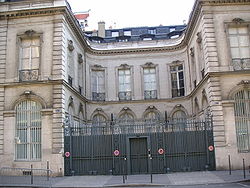
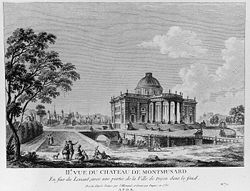
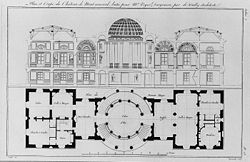
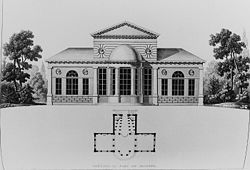
- Hôtel d'Argenson (also called the Hôtel de la chancellerie d'Orléans), near the Palais RoyalPalais RoyalThe Palais-Royal, originally called the Palais-Cardinal, is a palace and an associated garden located in the 1st arrondissement of Paris...
in Paris (destroyed in 1923): interior installations carried out for the Comte d' Argenson (1762–1770). - Transformation of the Château des Ormes in OrmesOrmesOrmes may refer to:*communes in France:**Ormes, Aube**Ormes, Eure**Ormes, Loiret**Ormes, Marne**Ormes, Saône-et-Loire**Ormes-et-Ville, Meurthe-et-Moselle**Les Ormes, Vienne**Les Ormes, Yonne...
(VienneVienneVienne is the northernmost département of the Poitou-Charentes region of France, named after the river Vienne.- Viennese history :Vienne is one of the original 83 departments, established on March 4, 1790 during the French Revolution. It was created from parts of the former provinces of Poitou,...
) for the comte d'Argenson. - Château de Montmusard near DijonDijonDijon is a city in eastern France, the capital of the Côte-d'Or département and of the Burgundy region.Dijon is the historical capital of the region of Burgundy. Population : 151,576 within the city limits; 250,516 for the greater Dijon area....
(Côte d'OrCôte-d'OrCôte-d'Or is a department in the eastern part of France.- History :Côte-d'Or is one of the original 83 departments created during the French Revolution on 4 March 1790. It was formed from part of the former province of Burgundy.- Geography :...
) (1765–1768): main architectural work of the Goût Grec in France, unfortunately mainly destroyed as of 1795. - Maison 57 rue La BoétieRue La BoétieThe rue La Boétie is a street in the 8th arrondissement of Paris, running from rue d'Astorg to avenue des Champs-Élysées.Number 45 is the location of the Salle Gaveau, a 1020-seat concert hall built in 1905-1906 by the architect Jacques Hermant, for the piano manufacturer Gaveau....
in Paris, constructed by De Wailly for himself (1776). - Maison 87 rue de la Pépinière, today rue La Boétie, for the sculptor Augustin PajouAugustin PajouAugustin Pajou was a French sculptor, born in Paris. At eighteen he won the Prix de Rome, and at thirty exhibited his Pluton tenant Cerbère enchaîné .-Selected works:...
. - Decoration of the chapel of the Virgin in Saint-SulpiceSaint-Sulpice (Paris)Saint-Sulpice is a Roman Catholic church in Paris, France, on the east side of the Place Saint-Sulpice, in the Luxembourg Quarter of the VIe arrondissement. At 113 metres long, 58 metres in width and 34 metres tall, it is only slightly smaller than Notre-Dame and thus the second largest church in...
(1774–1777). - Temple des Arts at the Château de MenarsChâteau de MenarsThe Château de Menars is a château associated with Madame de Pompadour situated on the bank of the Loire at Menars in France.-History:...
(Loir-et-CherLoir-et-CherLoir-et-Cher is a département in north-central France named after the rivers Loir and Cher.-History:Loir-et-Cher is one of the original 83 departments created during the French Revolution on 4 March 1790. It was created from parts of the former provinces of Orléanais and...
) for the marquis de Marigny. De Wailly also provided and project for a Temple du Repos for the park at Ménars, which was not executed. - Théâtre de l'Odéon (1779–1782) : From 1767, on commission from Marigny, Directeur des Bâtiments du Roi, Marie-Joseph PeyreMarie-Joseph PeyreMarie-Joseph Peyre was a French architect who designed in the neoclassical style.- Biography :He began his training in Paris with Jacques-François Blondel at l'École des Arts, where he met Giovanni Niccolo Servandoni and formed a life-long friendship with Charles De Wailly...
and De Wailly worked on the project for the new auditorium for the Théâtre-FrançaisComédie-FrançaiseThe Comédie-Française or Théâtre-Français is one of the few state theaters in France. It is the only state theater to have its own troupe of actors. It is located in the 1st arrondissement of Paris....
. The 26 March 1770, an order in council authorized the execution of the project on the grounds of the garden of the hôtelHôtel de CondéThe Hôtel de Mademoiselle de Condé, 12 rue Monsieur , has been referred to simply as the Hôtel de Condé, but this name can result in confusion, as it was also used for the main Paris seat of the princes of Condé. The building is also called the Hôtel de Bourbon-Condé, since it was built for Louise...
of the prince de Condé, who expected to be rid of the property in expectations of setting up in the Palais-Bourbon. De Wailly was the protégé of Marigny and Peyre the architect of the Condé, a friend of De Wailly since their days as pensionnaires in Rome. The project, revised more than once, had to undergo the approval both of the architects from the royal department in charge of fêtes and other entertainments, the Menus Plaisirs, Denis-Claude Liégeon et Jean Damun, who were backed by the members of the Comédie and also by the City of Paris, represented by its architect, Pierre-Louis Moreau-DesprouxPierre-Louis Moreau-DesprouxPierre-Louis Moreau-Desproux was a pioneering French neoclassical architect.Though he did not gain the Prix de Rome that was the dependable gateway to a prominent French career in architecture, his fellow-student Charles de Wailly invited him to share his prize...
. In the outcome, and thanks to the protection of MonsieurLouis XVIII of FranceLouis XVIII , known as "the Unavoidable", was King of France and of Navarre from 1814 to 1824, omitting the Hundred Days in 1815...
, brother of the King, the plans of Peyre and De Wailly finally won the day in the autumn of 1778. Works began in May 1779. Peyre would be principally responsible for the exterior and De Wailly for the interiors. On 16 February 1782, the troup of the Comédie-Française were established in their own precincts. The theatre was inaugurated by Marie AntoinetteMarie AntoinetteMarie Antoinette ; 2 November 1755 – 16 October 1793) was an Archduchess of Austria and the Queen of France and of Navarre. She was the fifteenth and penultimate child of Holy Roman Empress Maria Theresa and Holy Roman Emperor Francis I....
, 9 April 1782. - De Wailly gave an overall plan for the construction of the district around the new theatre, alloting a Cartesian planRené DescartesRené Descartes ; was a French philosopher and writer who spent most of his adult life in the Dutch Republic. He has been dubbed the 'Father of Modern Philosophy', and much subsequent Western philosophy is a response to his writings, which are studied closely to this day...
. The buildings however were not carried out until a long time after the completion of the theatre, towards 1794. - At the Église Saint-Leu-Saint-Gilles, Rue Saint-DenisRue Saint-Denis (Paris)Rue Saint-Denis is one of the oldest streets in Paris. Its route was first laid out in the 1st century by the Romans, and then extended to the north in the Middle Ages. From the Middle Ages to the present day, the street has become notorious as a place of prostitution...
in Paris: De Wailly created a choirQuire (architecture)Architecturally, the choir is the area of a church or cathedral, usually in the western part of the chancel between the nave and the sanctuary . The choir is occasionally located in the eastern part of the nave...
for the Order of the Holy SepulchreOrder of the Holy SepulchreThe Equestrian Order of the Holy Sepulchre of Jerusalem is a Roman Catholic order of knighthood under the protection of the pope. It traces its roots to Duke Godfrey of Bouillon, principal leader of the First Crusade...
, and an underground cryptCryptIn architecture, a crypt is a stone chamber or vault beneath the floor of a burial vault possibly containing sarcophagi, coffins or relics....
decorated in an original Doric order. - Project for embellishment of the town of Paris (1789): this first plan for remanagement acts to foreground the overall refitting of the capital, with creating new passageways, reuniting the îles de la Cité and Saint-Louis, correction of the course of the Seine, etc.http://gallica.bnf.fr/anthologie/notices/00442.htm
- Plan of new Port-VendresPort-VendresPort-Vendres is a commune in the Pyrénées-Orientales department in southern France.A typical Mediterranean fishing port, situated near the Spanish border on the cote Vermeille in south west France, Port-Vendres is renowned for its numerous fish and sea food restaurants. You can watch the fishing...
. - Chapelle du Reposoir, VersaillesVersaillesVersailles , a city renowned for its château, the Palace of Versailles, was the de facto capital of the kingdom of France for over a century, from 1682 to 1789. It is now a wealthy suburb of Paris and remains an important administrative and judicial centre...
.
Belgium
- Small theatre of the château de Seneffe à SeneffeSeneffeSeneffe is a Walloon municipality located in the Belgian province of Hainaut. On January 1, 2006 Seneffe had a total population of 10,743. The total area is 62.77 km² which gives a population density of 171 inhabitants per km²....
(1779). - Vaux-HallVauxhall, BrusselsThe Vauxhall was an entertainment building in Brussels Park in Brussels, Belgium. It is named after the pleasure gardens of Vauxhall in London, which only became known to the inhabitants of Brussels in 1761, when a ballet entitled Le Phaxal was put on at the Théâtre de la Monnaie...
(today: Cercle Royal Gaulois), BrusselsBrusselsBrussels , officially the Brussels Region or Brussels-Capital Region , is the capital of Belgium and the de facto capital of the European Union...
(1782). - Théâtre Royal du ParcThéâtre Royal du ParcThe Théâtre Royal du Parc is a theatre at 3, Rue de la Loi in Brussels, on the edge of the Parc de Bruxelles facing the Federal Parliament...
, BrusselsBrusselsBrussels , officially the Brussels Region or Brussels-Capital Region , is the capital of Belgium and the de facto capital of the European Union...
(1783). - Renovation of La MonnaieLa MonnaieLe Théâtre Royal de la Monnaie , or the Koninklijke Muntschouwburg is a theatre in Brussels, Belgium....
, Brussels (1785). - Château royal de Laeken.

